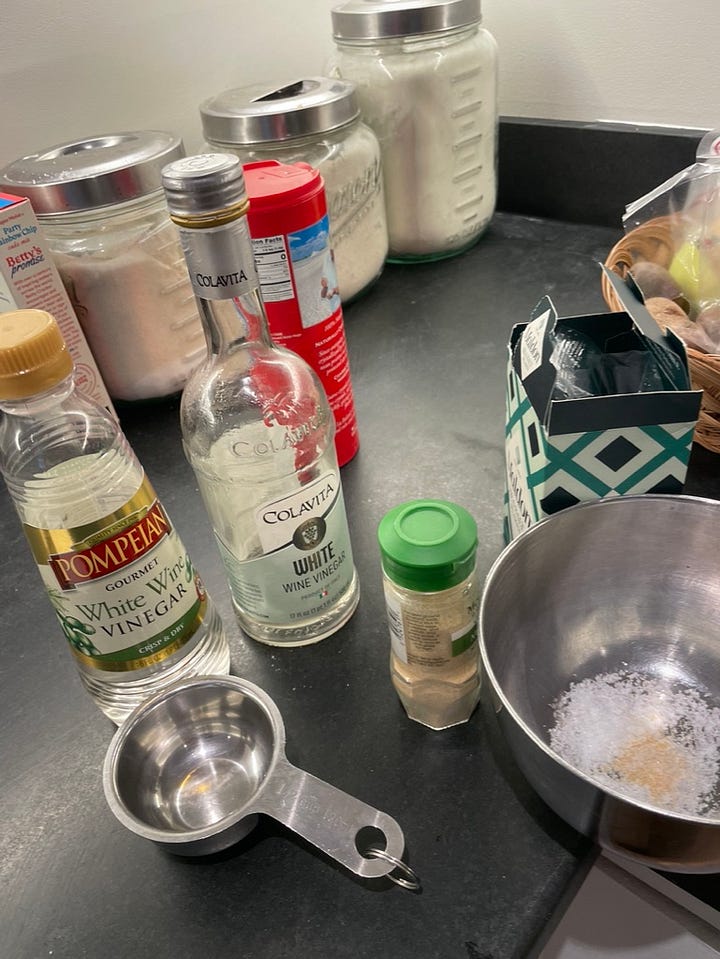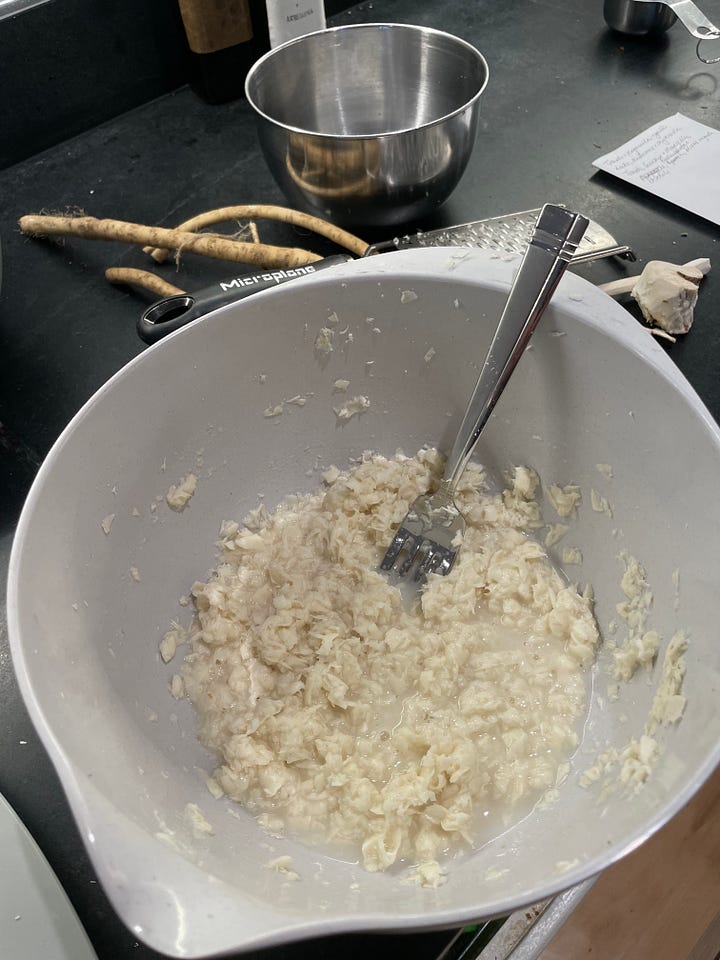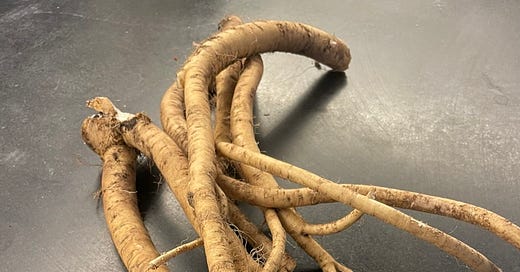A garden survivor that brings tears to my eyes
Horseradish roots are tough to control but produce a pungent condiment that comes into its own when the weather turns colder
When I was a kid my father would occasionally bring horseradish roots home, usually during the fall, and proceed to drive everyone out of the kitchen while he ground them up in our Cuisinart. The process filled the air with an eye-watering, nostril burning, unmistakable silent heat. My dad was a fruit and vegetable wholesaler in the Bronx, which for us meant a year-round supply of Florida peaches, Bibb and iceberg lettuce, cherries, beans, Jersey tomatoes, California melons, you name it. I wrote about him a few years ago for the Food section when I was at The Washington Post. (You can read the article here.)
Anyway, I don’t believe he sold horseradish, so he must have gotten it from other wholesalers at the sprawling market, formally known as the Hunts Point Produce Market, which supplied fresh produce for much of the New York metropolitan area. I’m sure they’d all trade, which is likely how he got his horseradish.
I remember him standing at the counter, apron on, eyes tearing as he determinedly processed those pure white roots into a coarsely ground pulp, then mixed it with white vinegar and maybe a little salt and put it into a jar. A taste before it went into the refrigerator would clear your sinuses and rinse your eyes. It would sting the tongue – and yet I loved it. We’d have it with steaks or a roast at Christmas. And it would add pizzazz to Bloody Mary’s.
When we bought our house in the Berkshires four years ago we discovered horseradish growing along the foot of a circular stone drywall near our patio and the kitchen door. It has large oval-shaped leaves that emerge each spring and grow at least two feet tall. We harvested some of the roots in the autumn a couple years ago but it was more than we could use. It also kept expanding. Horseradish is near-impossible to get rid of once established. If you leave even a tiny piece of root in the soil, it will grow into a plant the following year.
In an effort to get it under control – and move it away from the patio – I dug it up last fall, saved a couple four-inch long roots and planted them in a 20-gallon grow bag near the vegetable garden. I left them alone all summer as the leaves emerged and grew to their normal height. Horseradish should be harvested in the fall, so this past week I turned my attention to it and dug into the container to pull out the roots.
They may not have been as large as the roots of a more established plant growing in a garden bed, but there were more than enough. As a side note, a few roots did manage to push their way through the grow bag and into the soil underneath but I think I managed to dig them up. I took a couple and re-potted them into a larger, thicker plastic pot where they’ll remain through the winter and hopefully emerge next spring.
Once I got the harvested roots inside I brushed off the dirt and peeled them, revealing their pristine white flesh. Horseradish roots are similar to carrots, though longer and more ill-shaped. They run down into the soil and then can grow sideways, parallel to the surface. Once peeled, I decided to grate them by hand. I didn’t have that many and one of the chores I like least in a kitchen is cleaning a food processor.
True to form, the roots made my eyes tear and their pungent aroma filled the air. I worked alone, and it may not have been a coincidence that the dogs – who have been known to beat me to the kitchen when food is being prepared – were nowhere to be seen.


Preparing horseradish is easy, and the result is so much better than anything you can buy in the store. I followed a formula from a book called Saving the Season, by Kevin West, who lives part of the year nearby to us in the Berkshires. It’s an exhaustive guide to canning, pickling and preserving all types of fruits and vegetables.
His recipe:
¼ pound fresh horseradish root
½ teaspoon kosher salt
¼ teaspoon mustard powder
Pinch of sugar
⅔ cup of sherry or white wine vinegar
Peel the horseradish and finely grate it to yield 1 cup
Whisk the salt, mustard powder and sugar into the vinegar and pour it over the grated horseradish. Stir everything well to combine and store in a sealed jar in the refrigerator for up to a month.
Since we don’t eat beef at home, I divided the prepared horseradish into three jars, kept one for us and gave two to a couple neighbors who, like us, love to cook. One of them, a professional chef who cures and smokes his own salmon in a gorgeous cast-iron outdoor fireplace/smoker out behind his home, reminded me how well horseradish goes with smoked salmon and pork. Leftover turkey sandwiches as well, I’d think, and Thanksgiving is just around the corner.




